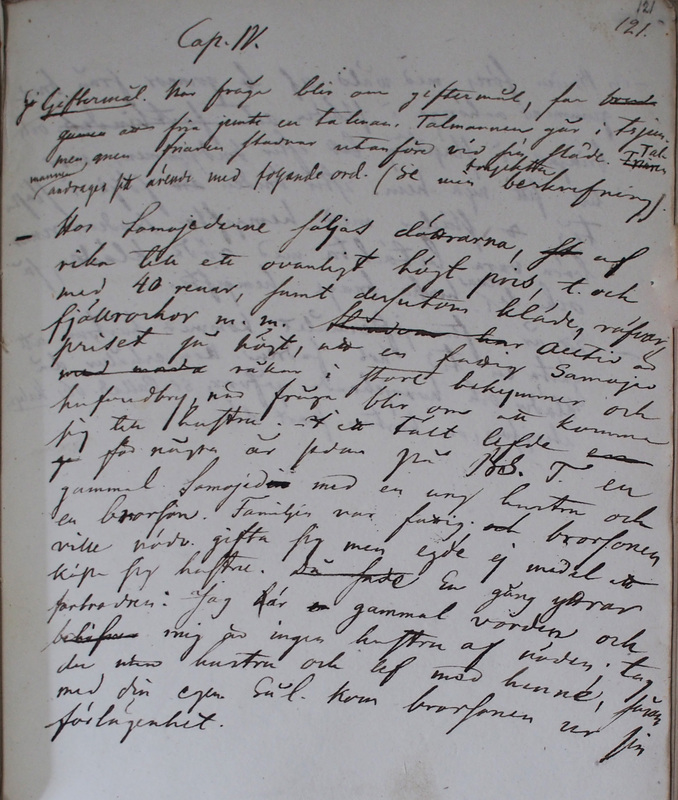Ethnographiska, historiska och statistiska anmärkningar. 121
Title
Description
| Cap. IV. |
Chapter IV |
|
Giftermål.
När fråga blir om giftermål, far brod-Matchmaking, roughly of a similar kind, is described in several sources. The dialogue is also noted down in note. (Zuev 1947: 60–62; Schrenk 1848: 474–479; Islavin 1847: 125–130; Chomič 1966: 162–173.)
gummen att fria jemte entalman. Talmannen går i tsjum- men, men friaren stadnar utanföre vid sin släde.Tal- mannen andrager sitt ärende med följande ord. (Se min tryckta beskrifvning).
Castrén’s description of a Nenets wedding, TN тюняʹ, is one of the earliest, together with Zuev’s and Beljavskij’s (Zuev 1947: 60; Beljavskij 1833: 118; see also Castrén 2019: 455–463.
|
Marriage. When it comes to marriage, the groom travels to propose marriage together with the matchmaker. The matchmaker goes to the tent, but the groom stays outside in his sledge. The matchmaker announces his business in the following words. (See my printed description.) |
| Hos Samojederne säljas döttrarna, af rika till ett ovanligt högt pris, t[ill]. och med 40 renar, samt dessutom kläde, räfvor fjällrockor m.m. Stundom har Alltid är priset så högt, att en fattig Samojed med mindre vållar i stort bekymmer och hufvudbry, när fråga blir om att komma sig till hustru.
I ett tält lefdeThe amount and quality of the bride price, TN неʹ мирʹ, was negotiated by the spokesman and the father of the bride. According to Chomič, the bride price typically consisted of (female) reindeer together with hides and clothes and sacred reindeer used for pulling sacred sledges. The dowry, TN нгэдинзэй, мядинзэй, paid by the family of the bride, included sledges with women’s clothes, household goods, food, and even a tent. As noted by Stammler, in the bride price the reindeer cannot be considered only through their economic value, but as “a kind of cultural property for maintaining relations within the community sphere”. The sense of reciprocity in the bride price and dowry is central for the Nenets, and these gifts can also be considered, in addition to being a price, as an exchange that builds long-term connections between families. (Chomič 1966: 165–167; Stammler 2005: 176–178)
för några år sedan på BS. T. [Bolschesemelska tundran] en gammal Samojedin med en ung hustru och en brorson. Familjen var fattig, och brorsonen ville nödv[ändigtvis]. gifta sig men egde ej medel att köpa sig hustru. Då sade En gång yttrar farbrodren: Jag här en gammal vorden och behafva mig är ingen hustru af nöden; tag du min hustru och lef med henne, såsom med din egen. Sål[unda]. kom brorsonen ur sin förlägenhet. |
Among the Samoyeds the daughters are sold, those of the rich at an unusually high price, even for 40 reindeer, as well as clothes, fox and Arctic fox skins, etc. The price is always so high that a poor Samoyed worries and troubles himself when it comes to finding a wife. A few years ago in the Bolshezemelskaja tundra, there was an old Samoyed living together with a young wife and a nephew. The family was poor, and the nephew insisted on marrying, but had no means to buy a wife. Once his uncle uttered: I will be old and in no need of a wife; take my wife and live with her as if she was your own. And that is how the nephew got out of his predicament. |

